Dissolved organic carbon concentration and its seasonal variation in the Huguangyan Maar Lake of Southern China
Grace A.Abarike·Zhiguang Song·Yongqian Han·Sibo Wang·Wen Bin·Liu Yaoqian
Abstract The dissolved organic carbon(DOC)in the surface water of Huguangyan Maar Lake was continuously monitored based on onceper week sampling frequency of 4 locations from June 2018 to May 2019.The DOC concentrations and its seasonal variation were discussed by correlating with the rainfall,water temperature,and pH of lakewater.Theresultsshowed that theweekly DOCvaried from 8.15 to 32.65 mg/L with an annual average concentration of 17.96 mg/L.There was a signif icant difference in the average DOC concentrations between the rainy and dry seasons as the monthly average DOC concentration was 21.72 mg/L for the wet season compared to the dry season concentration of 14.21 mg/L.The rainfall shows a significant effect on the DOC concentration of lake water,as DOC concentration was much high during the wet season.There were no signif icant spatial variations in the average monthly concentration among the four sampling locations except occasional variation during the wet season.The reason for the wet season DOC differences among four sampling locations is likely due to the uneven runoff and underground water inputs and the relatively slow circulation of lake water.Finally,theseasonal f luctuation of DOC concentration in this closed lake water suggests that dissolved soil organic matter inputs through the rainfall related to surface runoff and subsurface inf iltration from the surrounding watershed land is important to the primary production and organic matter deposition in the lake sediments.
Keywords Dissolved organic carbon·Seasonal variation·PH value·Rainfall·Huguangyan Maar Lake
1 Introduction
The water dissolved organic carbon(DOC)is one of the largest bioactive organic pools and plays an important role in the carbon cycle of the Earth’ssurface(Cole et al.2007;Song et al.2018).Although inland waters such as lakes occupy small proportions of the Earth’s surface,they have been suggested to have a signif icant effect on the global carbon cycle(Aherne and Farrell 2002;Cole et al.2007;Pan et al.2010)by storing and decomposing large amount of organic matter(Yu et al.2015).Lakes receive water from the surrounding landscape,connecting streams,rivers,etc.,therefore store a large amount of terrestrially derived carbon in the form of particulates and most of this carbon would eventually be mineralized and released into the atmosphere as CO2and CH4(Song et al.2018).In lakes,DOC indirectly controls the ecological functions by regulating the water transparency,penetration of UV radiations,and dissolved oxygen concentration(Eimers et al.2008).DOC concentration also largely affects a lake’s food web,metabolic activities in the water(Larsen et al.2011),and may also mediate the chemical environment of the water through the generation of organic acids(Brooks and Lemon 2007)which inf luences the solubility and bioavailability of metals(Eimers et al.2008)and nutrients in the water(Song et al.2018).Moreover,the abundance of DOC in lake water is affected by the water acidity,as the decline of DOC may indicate an increase in acidity of the lake and vice versa(Evans et al.2012;Keller et al.2008;Yallop et al.2010).There have been many studies around the world such as North America(Dean and Gorham,1998),western Europe(Woszczyk et al.2011),Asia(Song et al.2018;Wang et al.2012a,b),and other regions.Thesestudieshaveexplored thetemporal variation of DOC in coastal and fresh inland waters(Fang et al.2018;Kai et al.2019;Tranvik et al.2009;Wang et al.2015;Wen et al.2016;Zhao et al.2017),aimed to a better understanding of the primary production and organic carbon storage in the various water bodies.
Maar lakes are a typical kind of volcanic lake that has a unique water system(Christenson et al.2015)and are mostly closed with no inf low/outf low from rivers or streams(Fang et al.2018).The water supply of Maar lake is mainly groundwater,rainfall,and runoff.Therefore,the ecosystem of Maar lake is climate-sensitive(Ortiz et al.2013).Moreover,Maar lakes are mostly characterized by relatively small drainage basin and somewhat uniform geology(Martı´n-Serrano et al.2009).These morphological featuresof Maar lakespromote the continual accumulation and preservation of sediments(Allen et al.1999;Ortiz et al.2013)which makes them important subjects for paleoenvironmental,geophysical,paleoclimate,and geochemical studies(Chen et al.2021;Qiang et al.2018).The Huguangyan Maar Lake(shortened for HG Lake)issuch a unique lake that was developed from a volcanic crater and rimed by tephra(Christenson et al.2015).HG Lake is one of the largest volcanic lakes in the world and is reserved as a tourist site(Fang et al.2018).HG lake is regarded as a‘‘twin lake’’to Lake Eifel of Germany and was listed as a UNESCO geological park in 2006.The lake is located in the Leizhou peninsula which is affected by the East Asian monsoon climate(Wu et al.2012).The monsoon exhibits seasonal variations in atmospheric circulations and precipitation and is characterized by a rainy season from March to August(summer and spring)and a dry season from September to February(winter and autumn)(Huang et al.2010).Just like other Maar lakes,HG Lake is regarded as a unique water environment and its ecosystem has been affected solely by the regional climate changes,therefore bear scientif ic signif icance in studying the regional climate and environmental change(Fang et al.2018).In particular,because the organic matter in the sediments bears valuable information for paleoclimate studies,the DOC concentration and its variation are signif icant to the understanding of sedimentary organic matter formation and related regional climate conditions.The HG lake has been drawing attention from geologists due to its unique geological background.The f irst sediment core samples of HG Lake obtained in 1997(Mingram et al.2004)provided key information about climate change since the last glaciations.To date,substantial re-constructional studies of the lake’s sediments have improved the understanding of Holocene climatic evolution,paleoclimate changes,etc(Liu et al.2000;Mingram et al.2004;Yanchevaet al.2007,and referencetherein).Theknowledgeof surface water DOCmay further be required to improve the effective assessment of the contributions of lakes to the contemporary carbon sink.
2 Materials and methods
2.1 Geography of HG lake
HG Lake is located in the Leizhou Peninsula(21°9′N 110°17′E)of Guangdong province as shown in Fig.1 and is about 500 m away from the campus of Guangdong Ocean University.The water surface of HG Lake is about 2.1-2.25 km2with a maximum water depth of 20-21 m.HG Lake has a limited catchment area of 3.2 km2with no riverine input or output,and is almost immune to external water system interference(Fang et al.2018),thus changes in thelake’swater dependsmainly on thesupply of rainfall and groundwater level(Chen et al.2018).Furthermore,since the lake is surrounded by the rim formed by the volcanic eruption,the circulation of lake water is kind of slow.Thelakeisaffected by monsoon climateand portrays seasonal f luxesin atmospheric circulation and precipitation propagated by EASM that increases the rain and accounts for over half of the annual average precipitation of the area(Jia et al.2015)during the hot rainy months,i.e.from March to August(Huang et al.2010;Li et al.2012;Qiang and Yang 2008).The rainy season is accompanied by high atmospheric temperatures and weak winds that promote thermal stratif ication in the lake’s water column(Jia et al.2015).However,during the dry and cold months i.e.from September to April(Huang et al.2010;Li et al.2012),the EAWM prevails and breaks up this thermal stratif ication resulting in increasing primary productivity as it promotes the mixing of bottom nutrient-rich waters with the surface waters(Wang et al.2008,2009).Affected by the monsoon climate,thesurrounding site hasa recorded averageannual rainfall of about 1600 mm and a temperature of 23°C(Jia et al.2015;Shen et al.2013;Wang et al.2012a,b).
2.2 Lake water sampling and in-situ data acquisition
Surface water was taken using an amber high-density polyethylene(HDPE)bottle every Wednesday morning before 8 o’clock,starting from June 6,2018,until May 29 of 2019,from four sampling locations(numbered 1,2,3,and 4)of the HG Lake(Fig.1).The main consideration for the choice of four locations was based on the possible difference in the underground water supply and the effect of human activities.Thus,the sampling locations 1 and 2 are close to the main entrance area of the lake where more tourist activity was observed,while locations 3 and 4 are less-visited areas by the tourist.
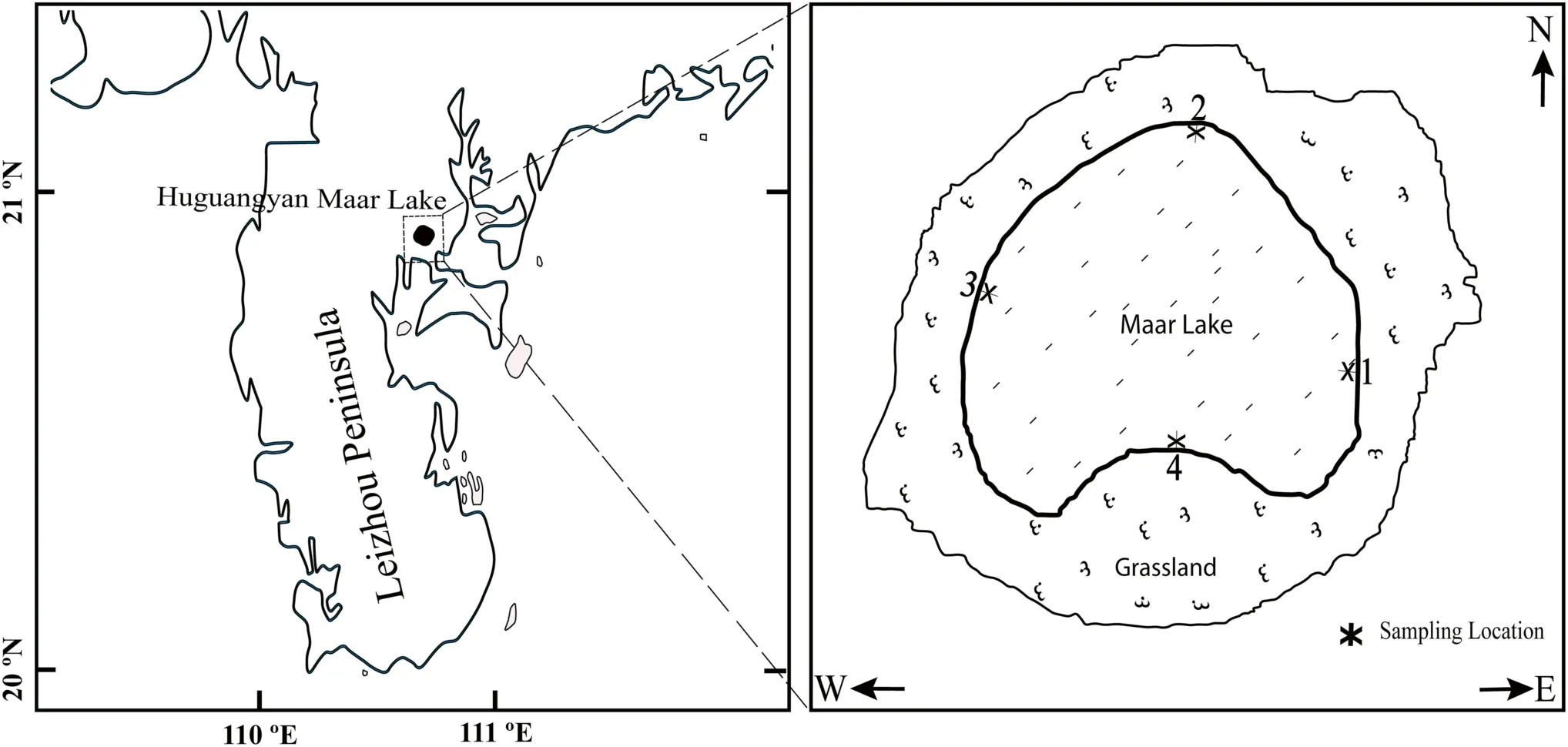
Fig.1 The geographical location of the study lake
A total of 208 surface water samples were collected during the 52 weeksof the sampling exercise.While taking the water samples,the surface water temperature and pH values were measured on-site using a Mercury thermometer and Mettler Toledo AG pH meter with LE438 probe,respectively.The pH meter was calibrated using standard Toledo technical buffer solution before each measurement.Daily rainfall data for the sampling period was obtained from a nearby meteorological f ield station monitored by the Zhanjiang Meteorological Bureau.
2.3 DOC measurements and data processes
After sampling,the water samples were immediately brought back to the laboratory(which is about 1 km away from the lake),f iltered using a 0.45μm Whatman GF/F f ilter,and stored in a fridge at temperatures of 4°C for DOC and other analyses.The water DOC concentration was determined using a modern Total Organic Carbon Analyzer(Vario TOC Elementar manufactured by Elementar Company,Germany).The inorganic carbon was removed from the sample by automatic acidif ication of the water samples with non-oxidative acid of HCl.The TOC Elementar was calibrated according to the manufacturer’s instructions,using the primary standard of potassium hydrogen phthalate(KHP).QA/QC KHP standards were run every 20-30 samples.All experiments were performed at the College of Chemistry and Environment laboratory of Guangdong Ocean University.
The DOC concentration of the water samples from all four sampling locations was averaged to obtain a mean DOC value which represented the weekly DOC content of the whole lake.And then the monthly DOC concentration was also calculated based on this mean weekly DOC concentration.The average weekly mean DOC was correlated with water temperature,pH values as well as rainfall to determine the inf luence of these factors on the DOC concentration.
3 Results and discussion
3.1 The DOC concentration of the surface water of HG lake
All weekly DOC concentration of the lake’s surface water from the four sampling locations is depictured in Fig.2.The weekly DOC concentration of the water samples from the four sampling locations 1,2,3,and 4 ranged from 7.02 to 49.61 mg/L,8.32 to 43.69 mg/L,6.89 to 41.99 mg/L,and 6.63 to 38.68 mg/L respectively.As shown in Fig.2,there are signif icant seasonal variations in the DOC concentration during the sampling period.The spatial variation in DOC of the lake water from the four locations was insignif icant.However,the DOC concentration displayed obvious spatial variation among the four locations during the high DOC concentration period i.e.from May to August,while less variation during the dry season of September to April when the DOC concentration is low.These f luctuations among the four sampling locations in DOC concentrations could be due to the spatial variations in the geographical condition such as the uneven underground water and surface runoff inputs as well as the relatively weak circulation of the lake(Keller et al.2008).

Fig.2 The weekly variation in DOC concentrations(mg/L)of the surface water of HG Maar Lake based on four location sampling measurements monitored from June 6,2018,to May 29,2019
The annual average DOC concentration of the lake’s surface water from the four sampling sites named 1,2,3,and 4 were 18.63,18.57,16.97,and 17.69 mg/L respectively(see in the supplementary table).The annual differences in the average DOC concentration among these four locations were also insignif icant,suggesting that DOC is homogeneously distributed in the surface water of thislake.However,despite exhibiting insignif icant annual variation in DOC concentration,the higher average annual DOC concentrations of sampling sites 1 and 2,compared with theother sampling locations(3 and 4),islikely due to their location in the lake which is in the north side,(Fig.1).Thus,sampling locations 1 and 2 may receive more sunshine during the day resulting in the thrive of microorganisms subsequently increasing primary production.Also,the watershed area of the north side is much large than that of the south side of the lake which may indicate much high underwater input through runoff and f iltration.Moreover,these two locations are close to the entrances of the lake thus,have increased proximity to frequent human disturbances during visits(Li et al.2012)such as the feeding of f isheswhich may introduce organic substancescontributing to the DOC loads(Table 1).
Averaging from the weekly DOC content of these four sampling locations,the weekly DOC concentration of the whole-lake displayed great variation ranging from 8.15 to 32.65 mg/L with an average annual concentration of 17.96 mg/L.By comparison to the surface water of other lakes,streams,and reservoirs in China and other parts of the world,HG Maar Lake shows a higher DOC concentration range(Table 2).The higher surface water DOC concentration of the HG Lake is likely due to its relatively closed water system(Fang et al.2018)that makes the lake water less prone to dilution from external water sources(Sobek et al.2007).This is similar to previous f indings where closed lakes of the endorheic regions of the Tibet plateau exhibited signif icantly higher DOC concentrations than theopen lakesdueto no f low export of thewater DOC(Wen et al.2019).However,compared to the eutrophic lakes in Northeast and Inner Mongolia-Xingjiang limnetic regions,and lakesin boreal regions,peatland catchmentsin the UK,Canada,North,East America,etc.(Evans et al.2005;Skjelkva°le et al.2005;Wen et al.2019)the mean DOC concentrations of the HG Lake is lower.This observed phenomenon could be due to the difference in lake trophic status,lake type,and the watershed landscape pattern of the lakes(Lee et al.2018;Oni et al.2011;Wen et al.2019).
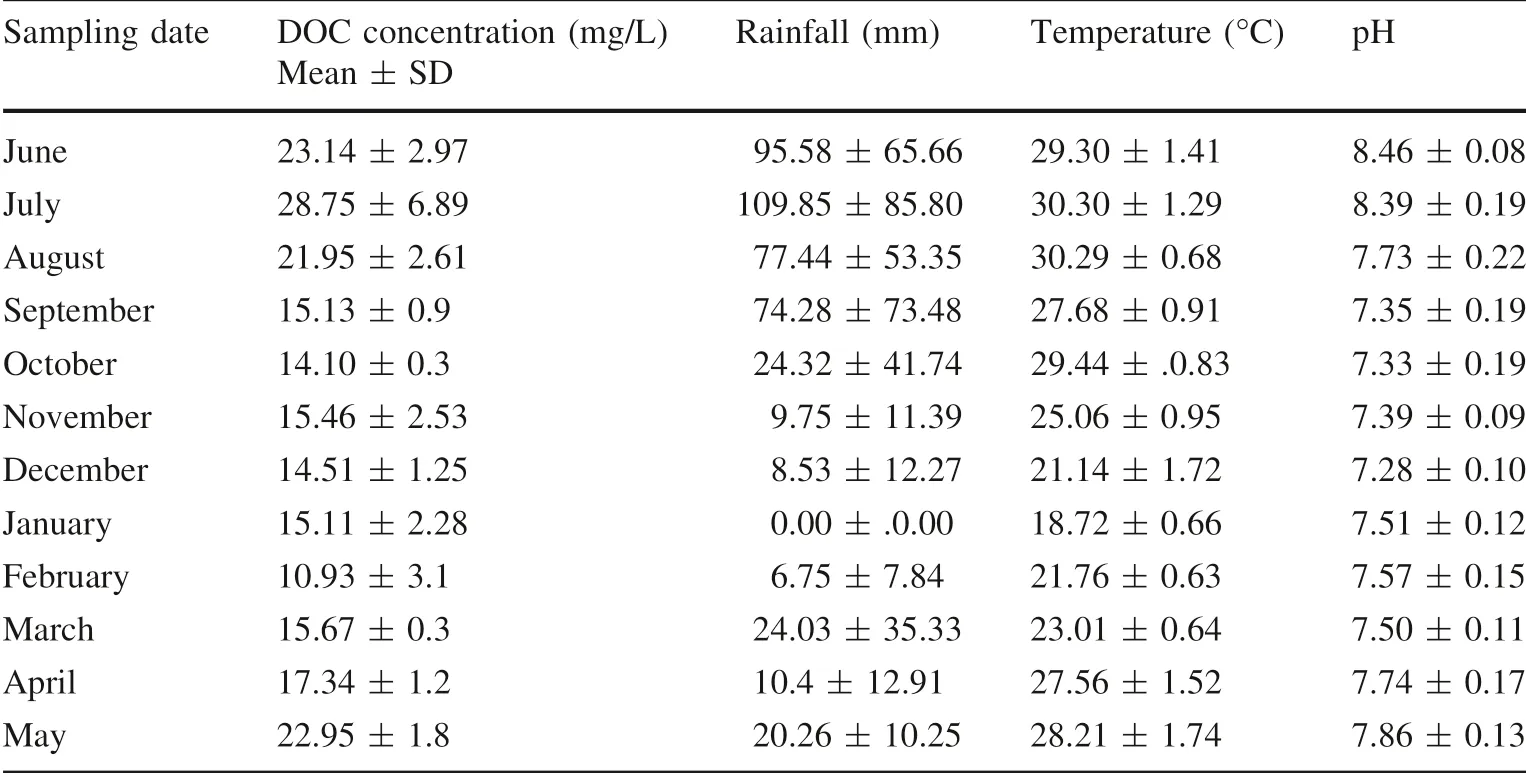
Table 1 The monthly average DOC concentration(mg/L),water temperature(°C),rainfall(mm),and pH values and their standard deviations(SD)of the HG Maar Lake monitored from June 6,2018,to May 29,2019
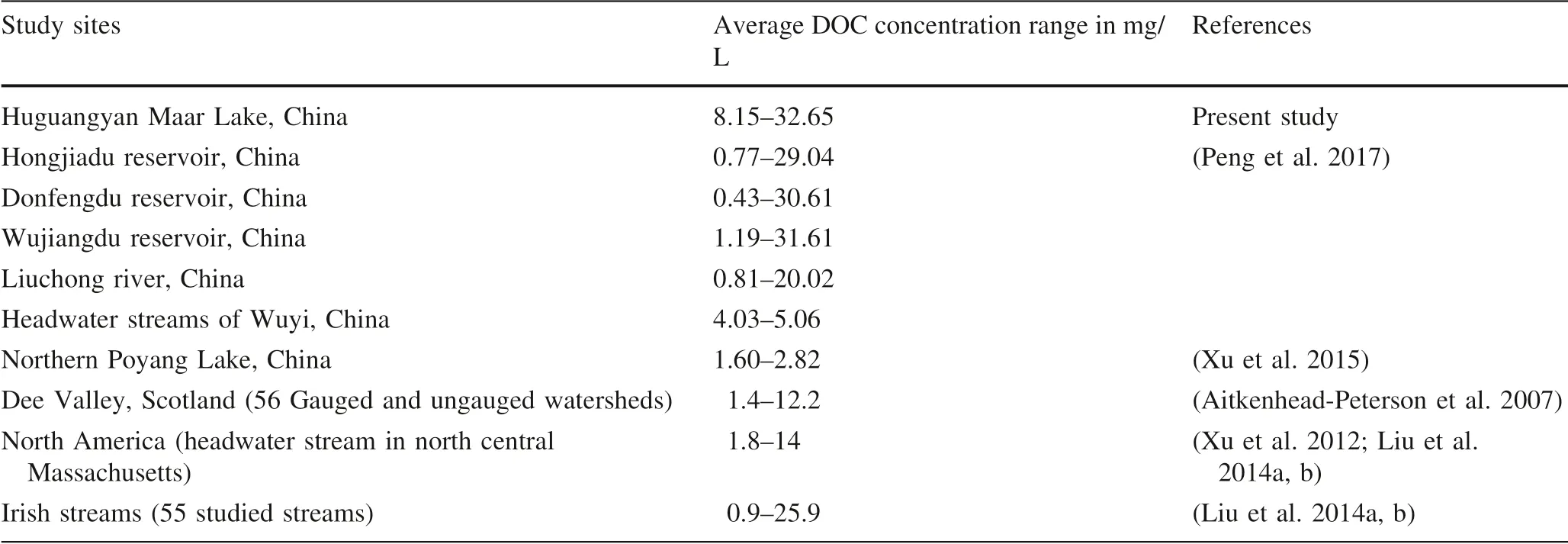
Table 2 Comparison of the surface water DOC concentrations in the Huguangyan Maar Lake with other studied water bodies(lakes,rivers,reservoirs and streams)in China and other parts of the world
3.2 The monthly and seasonal variation in DOC concentration
As shown in Table 1,the monthly mean DOC concentrations of the HG Lake ranged from low values of 10.93 mg/L in February to high values of 28.75 mg/L in July.The DOCconcentrationswere high from June to August(weeks 6.6-8.15).On theother hand,the DOCconcentrationswere signif icantly lower from September to May(week 9.5 to 5.29)(Figs.3,4,and 5).This revealed a typical seasonal pattern with the highest mean concentration of 24.45 mg/L during the summer(June,July August),followed by 18.98 mg/L during spring(March,April,and May),low concentration of 14.83 mg/L during autumn(September,October,and November),and the lowest concentrations of 13.59 mg/L during the winter season(December,January,and February),(Table 1).Both weekly and monthly average DOC concentrations indicated therefore that,the DOC concentration of the surface water of HG Lake was high in the rainy season but low in the dry season.
Seasonal variation in surface water DOC concentration of lakes or reservoirs has also been reported from several inland water bodies in China including Lake Bosten of the Xinjiang Province,Wulixia reservoir,Shuibuya reservoir over the Qingjiang river basin,Nam Co,and inf lowing rivers of Tibet Plateau(Fang et al.2018;Lu et al.2018;Kai et al.2019;Wang et al.2014;Zhao et al.2017).Seasonal changes are often associated with changes in land-use,climate change,temperature variation,changesin rainfall amounts,etc.and all these factorscould cause short term variations in the DOC concentration of lakes(Erlandsson et al.2008;Evans et al.2006;Valinia et al.2014;Weyhenmeyer and Karlsson 2009;Yallop et al.2010).Lake Bosten is one of the biggest inland freshwater lakesin China(Yao et al.2018)and it showed an average DOC of 9.3 mg/L during the summer season and 10.3 mg/L during spring and autumn(Wang et al.2014).The DOC concentration of 55 Irish streams was reported to be higher in autumn than in summer and winter(Liu et al.2014a,b).In the Xijiang River of South China,a higher DOC concentration of 1.40 mg/L wasrecorded during f lood seasonsbut a low concentration of 1.18 mg/L during the non-f lood season(Tao et al.2011).DOC concentration of northern Poyang Lake wasfound to berelatively low during thewet season(Xu et al.2015).The seasonal variation of DOC concentration in HG Lake is different from the temporary pattern of these other water bodies in China and around the world.Several factors may explain this difference including divergences in climatic,geopedological,topographical landscape conditions(Song et al.2018)and as well as the lake type.As large freshwater reservoirs,most of these lakes have external water input through connecting streams,rivers,etc.The external water input would increase during the wet season(Lu et al.2018)and therefore may have diluted the DOC concentration and resulted in a low DOC concentration of their lake water(Hudson et al.2003;Sobek et al.2007).But for the HG Lake,there is no riverine input or output and their watershed area is also small(Fang et al.2018).
3.3 Correlation between the DOC concentration and rainfall
It has been reported that the DOC concentration was lower during the raining season than that of the dry season in the Wulixiareservoir,China’sthird-largest body of freshwater,the Xijiang River of South China,the northern Poyang Lake,etc.due to the dilution factor of massive river input during the wet season(Liu et al.2014a,b;Lu et al.2018;Tao et al.2011).While the HG Maar Lake would receive most of its water inputs through runoff and inf iltration during the wet season and these processes may dissolve and transport more soil organic matter into the lake.Furthermore,studies on the evolution of both EASM and EAWM of HG Lake have shown that the lake is sensitive to Asian monsoon winds as thermal stratif ication of the water column builds up during EASM.Conversely,the emerging winds of the EAWM break up this thermal stratif ication of the water and facilitate the mixing of nutrient-rich bottom waters with the surface water which could then increase the DOC concentration during the dry season(especially in winter)(Jiaet al.2015;L.Wang et al.2012a,b,2008).In a recent study by(Jia et al.2015)to better understand the evolution of both EASM and EAWM during the Holocene,a high sedimentary TOC concentration during the dry season but low concentrations during the wet season of the HG Lake was found.However,this was not the case for the surface water DOC concentration of the HG Lake,as DOC concentrations were higher in the rainy season but low in the dry season.This could be explained by the timing and amount of rainfall which had a signif icant impact on the surface water DOC concentration of the HG Lake(Strock et al.2017;Valinia et al.2014).
As shown in Fig.3,during the rainy season,DOC concentration was higher during March to the middle of August which is generally the rainy season of Leizhou Peninsula,while the DOC concentrations are much lower during the dry season of low rainfall months from the middle of August to February.There was also a positive correlation between weekly rainfall and DOC concentration of the lake’s surface water.The average DOC concentration was 21.72 mg/L during the rainy season compared to the rather low value of 14.21 mg/L for thedry season.The statistical data in the region of HGLake during the sampling period showed a total of 123.63 mm rainfall in the dry season compared to a total of 337.56 mm rainfall in the rainy season(Table 1).Because lakes are often surrounded by high lands as a watershed,the high rainfall would have subsequently increased surface runoff and therefore increasing the terrestrial supply of organic matter into the lake water(Jia et al.2015;Strock et al.2017;Valinia et al.2014;Wu et al.2012).This is comparable with previous f indings from eight headwater catchments in Muskoka of central Ontario,lakes in the boreal ecozone north of Toronto,Ontario,where DOC concentration of lake waters increased during warm and high f low periods but declined in cold and low f low periods(Eimers et al.2008;Hudson et al.2003;Koehler et al.2009;McGlynn and McDonnell 2003).Moreover,the increased rainfall may lift the groundwater table to levels that come in contact with high organic matter containing soils and thus,the increase in DOC transport to the lake’s water by inf iltration process(Valinia et al.2014;Brage´e et al.2015;Strock et al.2017).On the other hand,less rainfall during the dry season may result in fewer amounts of DOC being transferred into the lakes through runoff and groundwater inf iltration,thuslower DOC-levels.Giving thefact that HG Maar Lake is a closed water system without riverine input and that thehigh DOCconcentration corresponded with the high rainfall suggeststhat rainfall and itsrelated inf iltration inputs are a major source of DOC to the surface water of HG Lake.
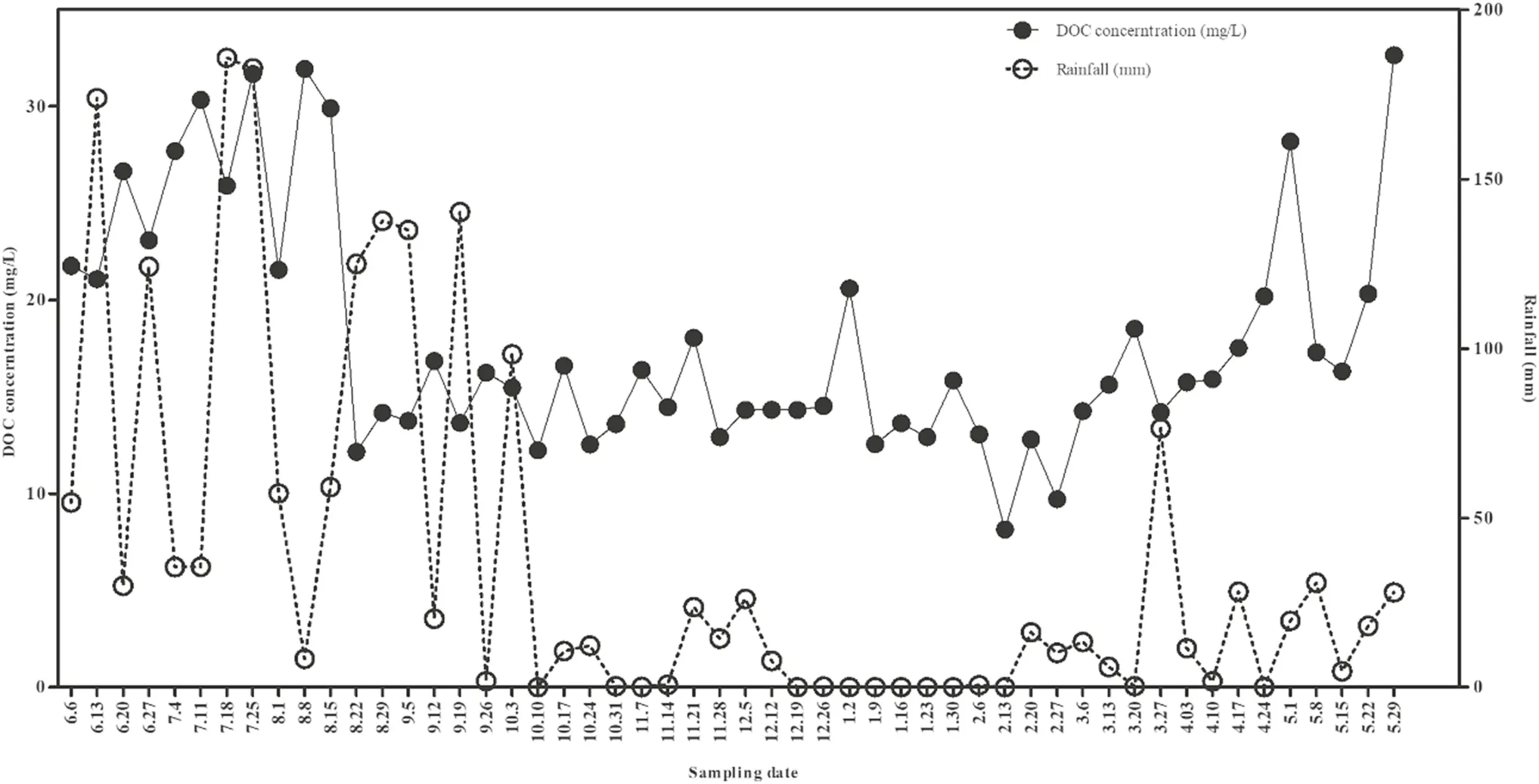
Fig.3 Temporal variation of the weekly rainfall(mm)and theaverage DOCconcentrations(mg/L)in thesurface water of HGMaar Lake drawn from the four location sampling measurements monitored from June 6,2018,to May 29,2019
The changes in DOC content of lake water are also related to the soil mineralization rates of the surrounding catchment,asorganic matter in soils istransported into the lake by runoff and other processes(Larsen et al.2011;Monteith et al.2007).However,the mineralization and decomposition of organic matter in soils are sensitive to moisture as well as temperature variations(Eimers et al.2008;Rey et al.2005).This could also further explain the variations in DOC concentrations between the dry and wet seasons,as heavy rainfall and high temperatures(Table 1)in the raining season may have increased the solubility of soil organic matter and therefore increased soil export processes,leading to increased DOC concentration of the lake’s water in the wet season compared with the dry season.
The DOC in lakes and other freshwater bodies are subjected to loss through photo-mineralization(Hudson et al.2003;Saros et al.2015;Selvam et al.2019).The photo-mineralization of DOC is induced by UV sunlight irradiations which oxidizes DOC into CO2,carbon monoxide(Selvam et al.2019),etc.A balanced study of 12 years of data in Dorset lakes estimated the photo-decomposition processasthe major potential losspathway of allochthonous DOC(Molot and Dillon 1997).Likewise,lake Terjevann of Norway wasreported to have lost 33%of its organic matter to photo-decomposition processes(Andersen and Gjessing,2002).However,the loss of DOC through this process is inf luenced by several factors including the DOC loads(Hanson et al.2011;Reche et al.2000).The increase in DOC concentration would reduce the UV penetration and subsequently slow down thephotomineralization processes(Hanson et al.2011;Hudson et al.2003;Obernosterer and Benner,2004;Reche et al.2000).With regardsto this,theincreased transport and subsequent increases in DOCconcentration during high rainfall season may have also reduced the UV light penetration hence prevented the photo-oxidation and excess loss of DOC in the lake.The photo-mineralization processes could also well explain the low DOC concentration of HG Maar Lake during the dry season.
3.4 Correlation between the DOC concentration and water temperature
Temperature has been identified as a potential driver of DOC concentration in lake waters(Erlandsson et al.2008;Evans et al.2006;Weyhenmeyer and Karlsson,2009),as DOCconcentration may decrease astemperature decreases and vice versa(Pan et al.2010).The measured weekly water temperature(which is measured before 8 a.m.of each Wednesday during the sampling period)of the HG Maar lake,varied from 16.90 to 31.13°C with an annual average of 25.95°C.As shown in Fig.4,the high DOC concentration was somehow associated with the higher water temperature suggesting that water temperature may havehad apositiveeffect on the DOCconcentration.These results agree with f indings from other lakes and inland waters which suggest that during high temperatures,DOC concentration is likely to be increased.Examples of such f indings include;the DOC concentration in the rivers of Tibet Plateau which peaked in late spring and summer but were low in winter(Kai et al.2019).Results from multiple linear regression models indicated that an increase in temperature resulted in increased DOC export to lakes of Boreal Shield in Ontario(Keller et al.2008).It is also found that an increase of 0.66°C at the upland catchments in the United Kingdom would cause about a 65%increase in the DOC concentration of the stream(Freeman et al.2001).
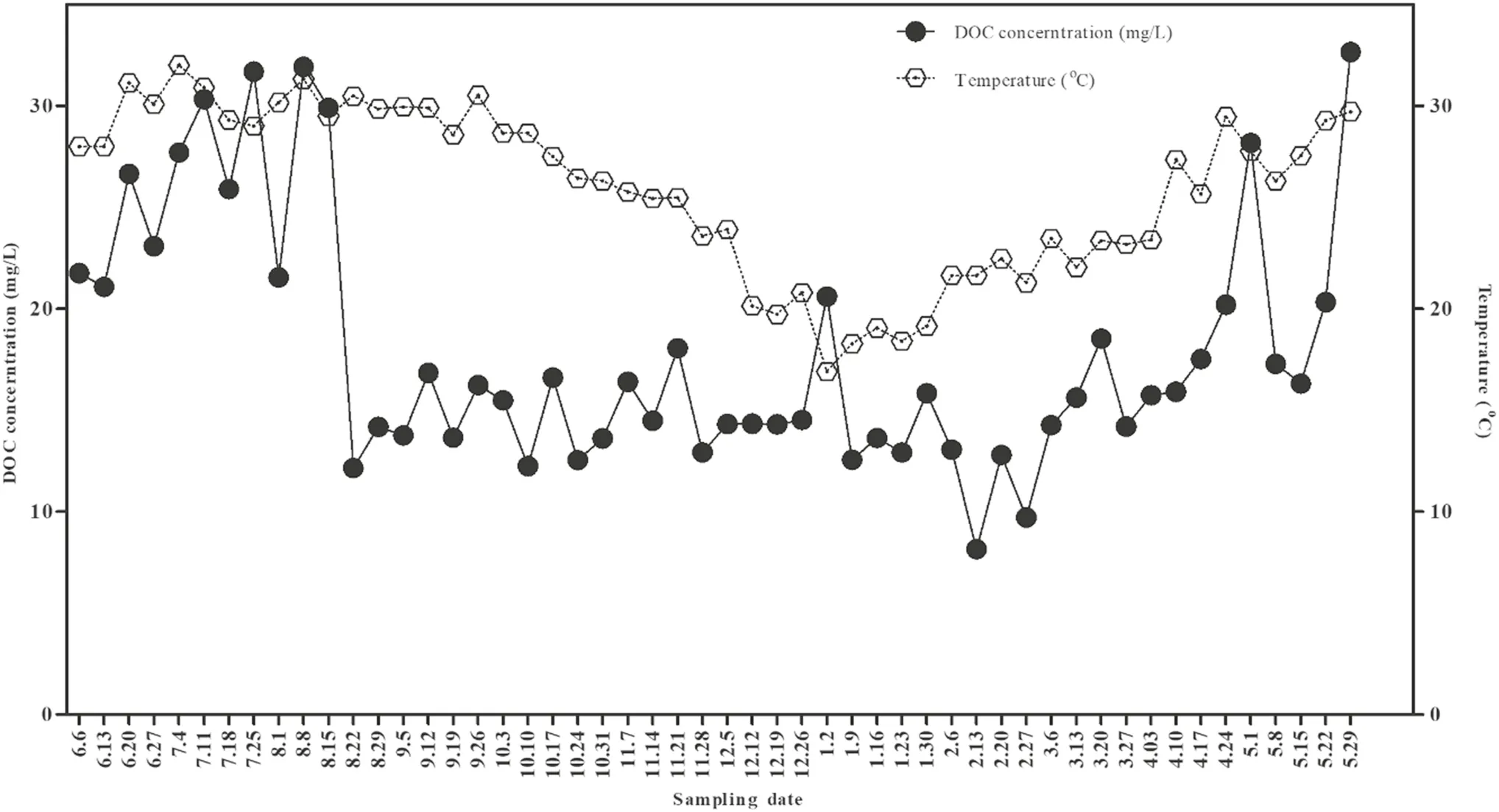
Fig.4 Temporal variation in theweekly average DOCconcentrations(mg/L)and surface water temperature(°C)of HGMaar Lake drawn from the four location sampling measurements monitored from June 6,2018,to May 29,2019
Lake’s microbial activities are a major source of autochthonous DOC in the water(Koehler et al.2009).Higher water temperature will enhance these microbial activities and accelerate primary production and therefore increase the DOCconcentration(Freeman et al.2001).On the other hand,a low water temperature would reduce or slow the microbial activities and therefore result in a declined DOC concentration in the lake(Eimers et al.2008;Li et al.2012).This could partly explain the low DOC concentration during the dry season compared with the high DOC concentrations in the rainy season.However,the correlation between the DOCconcentration and water temperature is somehow complicated asin Fig.6;it is shown that there is a positive but not a linear correlation but an inverted L shape between DOC versus Temperature.This suggests that water temperature may have a more complicated inf luence on the DOC concentration of HG Maar Lake.At higher water temperatures the solubility of organic matter in the water may increase but the primary production could be lower and this could result in a relatively low DOC concentration in the lake water during the hot and dry season(Laudon et al.2012;Toming et al.2020).Anyway,the water temperature may not be an independent factor affecting the water DOC of this lake.
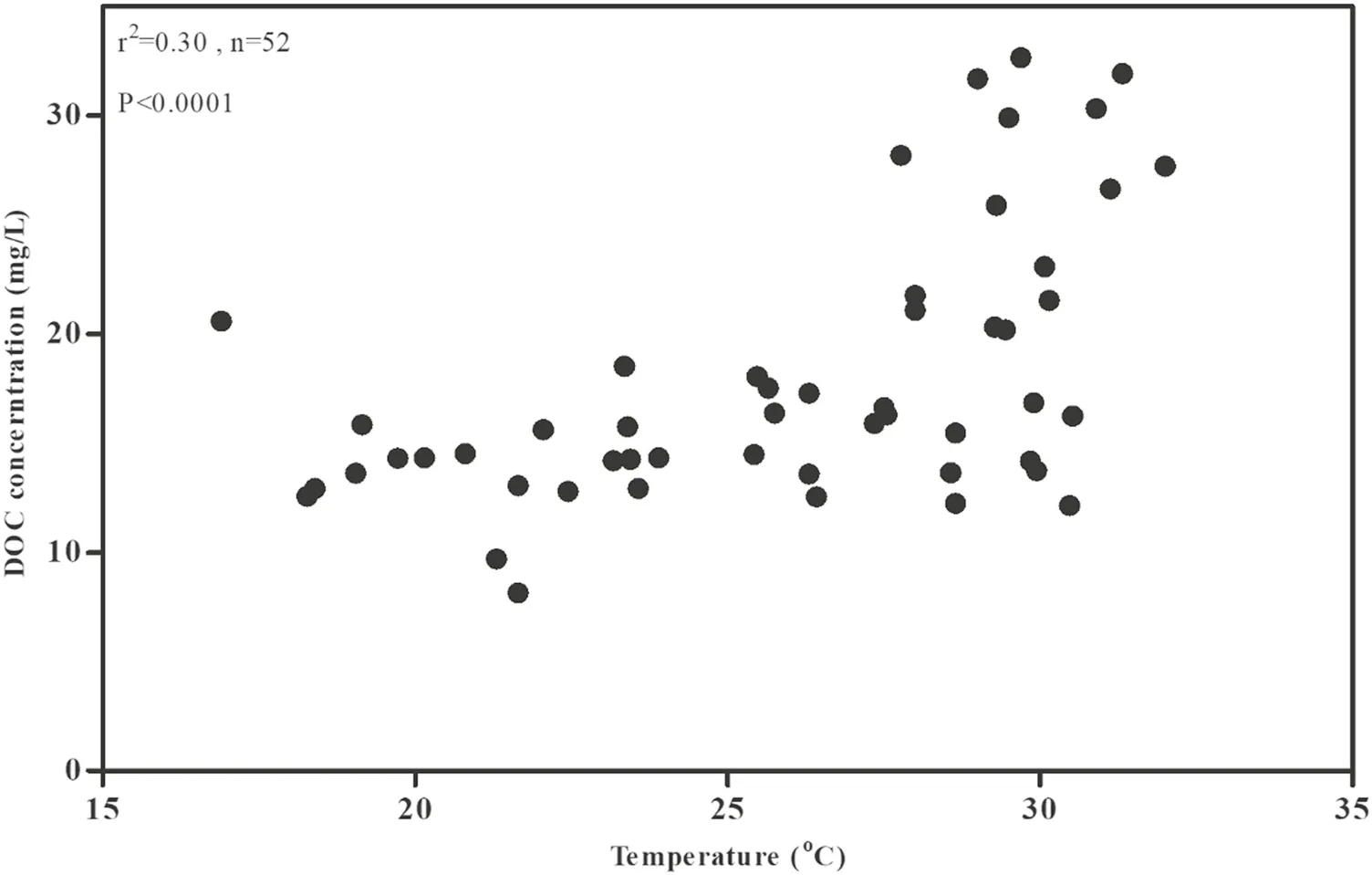
Fig.6 A correlation of the weekly average DOC concentrations(mg/L)and water temperature(°C)of the surface water of HG Maar Lake based on four location sampling measurements monitored over the period of June 6,2018,-May 29,2019
3.5 Correlation between DOC concentration and p H values
Previous studies have shown that acidif ication is a controlling factor of the DOC concentration in lakes(Brage´e et al.2015;Monteith et al.2007;Valinia et al.2014).Acidif ication of surface water would reduce the DOC concentration through accelerated photo-degradation of organic matter in the water(Hudson et al.2003).Acidif ication of a lake’s water could be caused primarily by acid rain which brings a signif icant amount of airborne sulfur(S)and nitrogen(i.e.NOxand SO2).Pregitzer et al.(2004)had proposed a positive correlation between nitrogen deposition and DOC leaching.The freshwater in Swan lakes of the Sudbury showed signif icant long-term changes in DOC as a result of variations in pH(Keller et al.2008).DOC concentrations of some lakes studied in southern Sweden were found to be low due to its lower pH value caused by high sulfur deposition(Valinia et al.2014).
The pH value of the surface water in HG Maar Lake ranged from 7.2 to 8.5 with an annual average of 7.6(Fig.5),and therefore the lake water is slightly alkaline.The pH values and range are similar to that of Sihailongwan Maar lake(Fang et al.2018).Figure 5 showed that most of the high pH values were associated with the high DOC concentration,while Fig.7 displayed a slightly positive correlation between DOC concentration and pH values.These also suggest that pH value has a positive effect on the DOCconcentration of HGMaar Lake,i.e.the higher the pH value the higher the DOC concentration.However,the reason for the positive effect of the higher pH value on the DOC concentration may be complicated because the high pH value is also associated with the high amount of rainfall(Table 1).Because the HG Maar Lake is not far from the coast of the South China Sea,Fig.1,which is characterized by high salinity seawater,therefore,it is expected that the East Asian monsoon would bring high salinity rainfall which would contain a higher amount of alkaline ions.So,it is questionable if the positive correlation between the pH value and the DOC concentration is a coincidence or causation, and this needs further investigation.
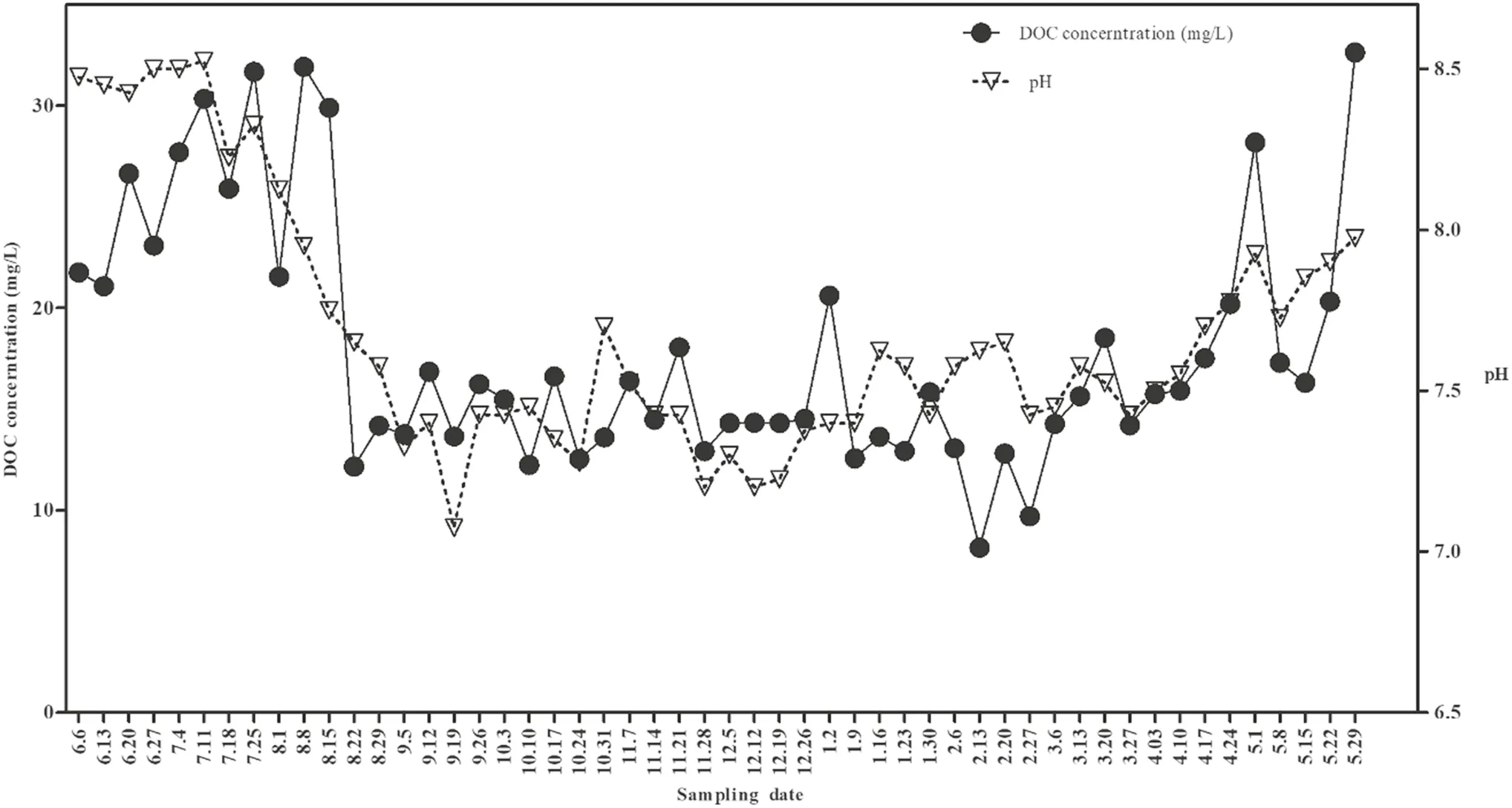
Fig.5 Temporal variation in the average weekly DOC concentrations(mg/L)and pH values of HG Maar Lake drawn from the four location sampling measurements monitored from June 6,2018,to May 29,2019
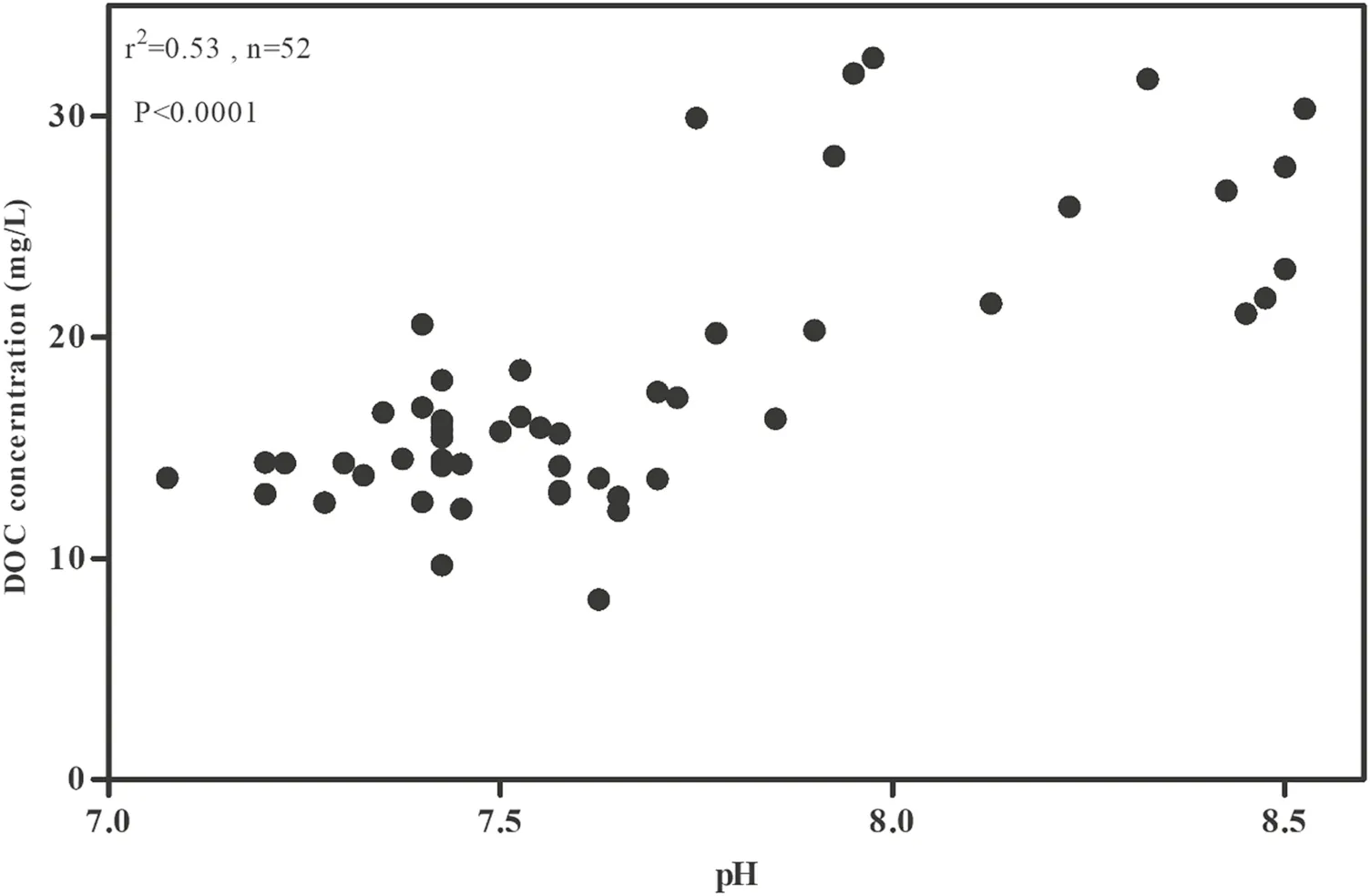
Fig.7 A correlation of the weekly average DOC concentrations(mg/L)and pH values of the surface water of HG Maar Lake based on four location sampling measurements monitored from June 6,2018,to May 29,2019
4 Conclusions
By investigating the DOC concentration of surface water and its seasonal changes in the Huguangyan Maar Lake over ayear,thefollowing major pointscould beconcluded:
(1) The weekly average DOC content of the whole-lake varied from 8.15 to 32.65 mg/L during the sampling period with an average annual concentration of 17.96 mg/L.In general,the DOC concentration showed no signif icant variation among the four sampling locations except seasonal-related occasional changes.
(2) There was a clear seasonal variation in the DOC concentration between the rainy and dry seasons,as the average monthly DOC concentration of the wet season was 21.72 mg/L compared to the DOC concentration of 14.21 mg/L for the dry season.
(3) The higher DOC concentration in the rainy season corresponded with high rainfall,higher water temperature,and pH value and vice versa in the dry season.However,the correlation between DOC,water temperature,and pH values appears to be complicated and requires further studies.
(4) There was occasional signif icant spatial variation in the DOC concentration among four sampling locations during the wet season and the reason for this is likely due to the uneven underground water and surface runoff inputs,and the weak circulation of lake water.
(5) The seasonal f luctuation of DOC concentration in this closed lake suggests that the soil organic matter inputs,which are mainly regulated by the rainfallrelated surface runoff and subsurface inf iltration from the surrounding watershed land,may play a signif icant role in the ecosystem of the lake.
AcknowledgementThe authors are grateful to the administration of the Huguangyan Maar Lake for free entrance permission to collect water samples and to the Zhanjiang Meteorological Bureau for access to the regional meteorological data.This study was funded by the Special Talent Support Program of Guangdong Ocean University(No.R17001)and the Project of Marine geochemistry and climate change of Guangdong Ocean University(No.002026002004).
FundingThis study was funded by the Special Talent Support Program of Guangdong Ocean University(No.R17001)and the Project of Marine geochemistry and climate change of Guangdong Ocean University(No.002026002004).
Data availabilityThe datasets generated and/or analyzed during the current study are available from the corresponding author on reasonable request.
Declaration
Conf lict of interestWe declare that there isno conf lict of interest of any form that could inappropriately inf luence this work.
Consent for publicationAll authors are aware of the intended publication.
Acta Geochimica2021年5期
- Acta Geochimica的其它文章
- Source characteristics and genesis of Sb mineralization from the Au and Sb deposits of the Youjiang Basin,SW China:constraints from stibnite trace element and isotope geochemistry
- Late Jurassic adakitic ore-bearing granodiorite porphyry intrusions in the Xiaokele porphyry Cu(-Mo)deposit,Northeast China:implications for petrogenesis and tectonic setting
- Mineralogy and geochemistry of the Ngaoundaba Crater Lake sediments,northern Cameroon:implications for provenance and trace metals status
- Re-Osdating,and Pb-H-O isotopecharacteristics,of the Abra Cu-Ag-Pb-Au polymetallic deposit in Western Australia
- Geochemistry of platinum-group elements in the podiform chromitites and associated peridotites of the Nain ophiolites,Central Iran:Implications for geotectonic setting
- Geochemistry,geochronology,and zircon Hf isotopic compositions of felsite porphyry in Xiangshan uranium oref ield and its geological implication
